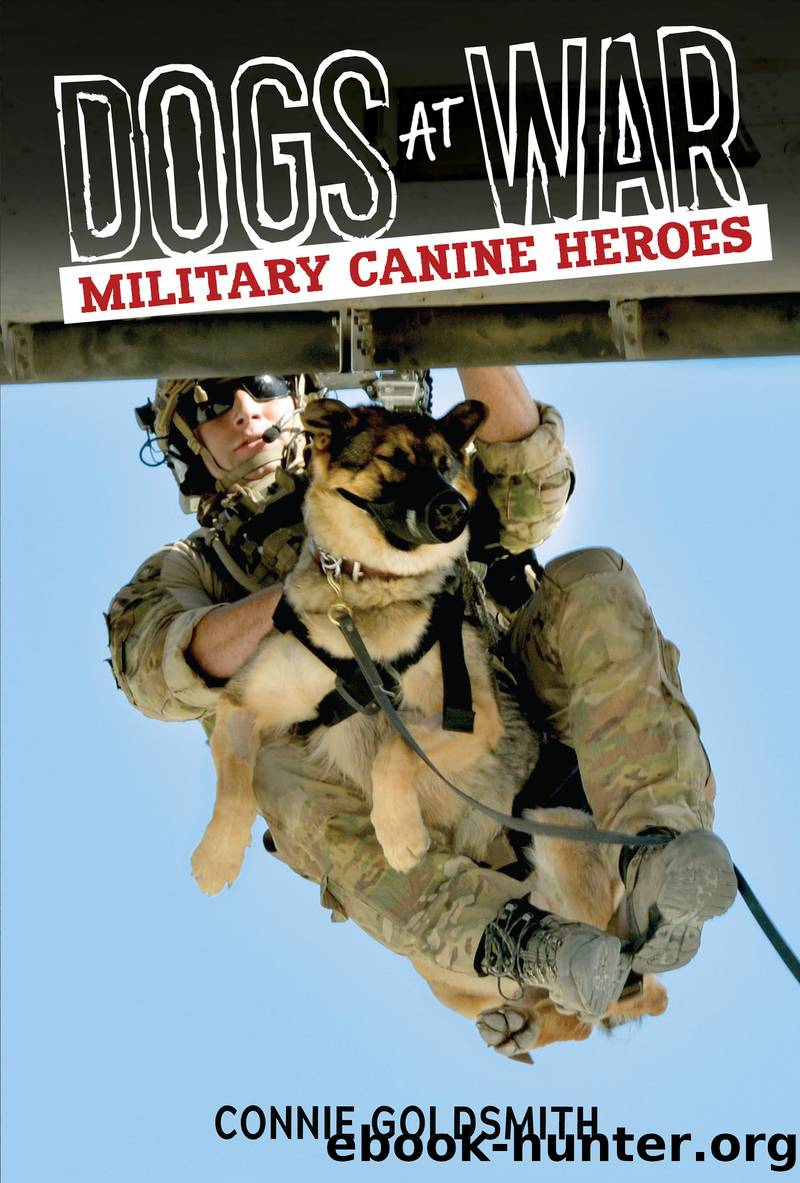Dogs at War: Military Canine Heroes by Connie Goldsmith

Author:Connie Goldsmith [Goldsmith, Connie]
Language: eng
Format: epub
Tags: Nonfiction, Young Adult Nonfiction, Young Adults, Animals, Animal, General, Animals, Animal, History, Military, Wars, War, Military & Wars, Animals, Animal, Animal Welfare, Afghanistan War, America, American History, American Military History, Animal Behavior, Bomb Sniffing Dogs, Canine, Canines, Dog, Dog Training, Dogs, Dogs and Puppies, Dogs at War, Drug Detection Dogs, Fostering Dogs, German Shepherd, German Shepherds, Guard Dog, Guard Dogs, IED, IEDs, Iraq War, Labrador Retriever, Labrador Retrievers, Lackland Air Force Base, Military & Wars, Military Canine Heroes, Military Dogs, Military History, Military Working Dog, Military Working Dogs, Post traumatic stress disorder, PTSD, Robby's Law, Training Dogs, United States, US Air Force, US Army, US Military, Veterinary Medicine, Vietnam War, Working Dog, Working Dogs
ISBN: 9781512439069
Publisher: Lerner Publishing Group
Published: 2017-01-01T00:00:00+00:00
US Marine lance corporal Brandon Mann and his MWD, Ty, clear a hill in Sre Kala, Afghanistan, for weapons and IED caches during a patrol in 2012. The United States went to war with Afghanistan shortly after the September 11, 2001, terrorist attacks in the United States.
Handler Mike Dowling described a typical mission in Iraq. Mike and his MWD Rex usually spent the day searching for IEDs hidden under mounds of rubble and trash along roads. The enemy had rigged many of the IEDs of that period so they could trigger them with a simple cell phone call. Bomb makers would connect electrical wire to a cell phoneâs antenna and from there to a car battery and then to the hidden IEDs. The bomb maker could then watch through binoculars from a distance. When US soldiers, war dogs, or other military personnel neared a hidden IED, the bomb maker used a second cell phone to call the rigged cell phone. When that cell phone rang, it completed an electrical circuit and set off the bomb. Other IEDs were set to explode when someone stepped on a pressure plate hidden under the sand.
Enemy combatants in the Middle East typically placed IEDs in towns and villages or along roads, hiding them in vehicles and deserted houses. Suicide bombers would wear IEDs in suicide vests, head for a crowded area, and then trigger the device to explode. Often exploding IEDs signaled the beginning of a battle, with gunfire and more IED explosions to follow. The US military estimates that IEDs caused between one-half and two-thirds of US deaths and injuries in Iraq and Afghanistan. As of summer 2016, the US death toll in both countries had neared seven thousand, while at least nine hundred thousand had been injured.
Outside the Wire
MWDs deployed to Afghanistan performed several important tasks. About 95 percent of the dogsâ work in Afghanistan was sniffing out bombs. They also searched cars and trucks, deserted mud huts, rocky roadsides, and fields filled with crops of grapes and grain for hidden enemy insurgents. Dogs protected their handlers, patrolled and guarded American bases, and saved American lives.
Dog teams routinely go outside the wireâleaving the safety of the baseâto conduct missions. For example, in Glory Hounds, a 2013 Animal Planet documentary about four dog teams in Afghanistan, viewers follow handlers and dogs as they enter private homes where Taliban insurgents often hid weapons and bomb-making materials among civilian families. Dog teams were responsible for clearing an areaâensuring it was safeâbefore other soldiers entered. âOur goal is to . . . save someoneâs life, especially American lives,â US Marine Kent Ferrell said of his work with MWD Zora. âThatâs what weâre [in Afghanistan] for. Thatâs our job.â
Just how good are MWDs at saving lives? Technical Sergeant Justin Kitts received a Bronze Star (a US military decoration awarded for heroic or meritorious achievement in combat) in 2011 for his work in Afghanistan with his dog Dyngo. The US military credits Kitts and Dyngo with having protected
Download
This site does not store any files on its server. We only index and link to content provided by other sites. Please contact the content providers to delete copyright contents if any and email us, we'll remove relevant links or contents immediately.
Pale Blue Dot by Carl Sagan(4956)
Cracking the GRE Premium Edition with 6 Practice Tests, 2015 (Graduate School Test Preparation) by Princeton Review(4250)
Pocahontas by Joseph Bruchac(4214)
Unfiltered by Lily Collins(3983)
The Emotionary: A Dictionary of Words That Don't Exist for Feelings That Do by Eden Sher(3333)
The Daily Stoic by Holiday Ryan & Hanselman Stephen(3264)
Factfulness_Ten Reasons We're Wrong About the World_and Why Things Are Better Than You Think by Hans Rosling(3216)
The 48 laws of power by Robert Greene & Joost Elffers(3147)
The President Has Been Shot!": The Assassination of John F. Kennedy by Swanson James L(3070)
Sapiens and Homo Deus by Yuval Noah Harari(3029)
Rogue Trader by Leeson Nick(3010)
The Innovators: How a Group of Hackers, Geniuses, and Geeks Created the Digital Revolution by Walter Isaacson(2997)
Gettysburg by Iain C. Martin(2805)
The Rape Of Nanking by Iris Chang(2795)
Almost Adulting by Arden Rose(2685)
The Plant Paradox by Dr. Steven R. Gundry M.D(2581)
In the Woods by Tana French(2561)
500 Must-Know AP Microeconomics/Macroeconomics Questions(2546)
Make by Mike Westerfield(2304)
